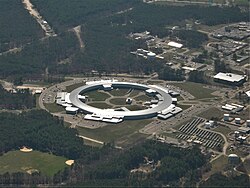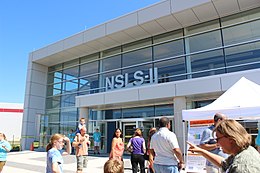This article contains content that is written like an advertisement. Please help improve it by removing promotional content and inappropriate external links, and by adding encyclopedic content written from a neutral point of view. (March 2024) (Learn how and when to remove this message)
|
The National Synchrotron Light Source II (NSLS-II) at Brookhaven National Laboratory (BNL) in Upton, New York is a national user research facility funded primarily by the U.S. Department of Energy's (DOE) Office of Science. NSLS-II is a synchrotron light source, designed to produce X-rays 10,000 times brighter than BNL's original light source, the National Synchrotron Light Source (NSLS). NSLS-II supports basic and applied research in energy security, advanced materials synthesis and manufacturing, environment, and human health.[4]
| NSLS-II | |
|---|---|

An aerial view of the National Synchrotron Light Source II (NSLS-II) at Brookhaven National Laboratory
| |
 | |
| General information | |
| Type | Research and Development Facility |
| Town or city | Upton, New York |
| Country | United States |
| Coordinates | 40°51′55.38″N 72°52′19.71″W / 40.8653833°N 72.8721417°W / 40.8653833; -72.8721417 |
| Construction started | 2009 |
| Completed | 2015[1] |
| Cost | US$912 million |
| Owner | United States Department of Energy |
| Technical details | |
| Floor area | 400,000 sq ft (37,000 m2)[2] |
| Design and construction | |
| Architecture firm | HDR, Inc. |
| Main contractor | Torcon, Inc.[3] |
| Website | |
| BNL: National Synchrotron Light Source II (NSLS-II) | |

In order to use the NSLS-II, researchers have to submit a peer-reviewed proposal.[5] In the first five months of 2023, NSLS-II served over 1,200 researchers from academic, industrial, and government laboratories worldwide.[6]
NSLS-II partners with public and private institutions have joined effort to fund the construction and operation of some of its beamlines. Its partnerships include BNL's Center for Functional Nanomaterials and the National Institute of Standards and Technology, among others.[citation needed]
NSLS-II currently has 29 beamlines (experimental stations) open for operations.[7] When the facility is complete, NSLS-II is expected to "be capable of supporting some 58 beamlines in total."[8]
The beamlines at NSLS-II are grouped into five science programs: hard x-ray scattering & spectroscopy, imaging & microscopy, structural biology, soft x-ray scattering & spectroscopy, and complex scattering. These programs group beamlines together that offer similar types of research techniques for studying the behavior and structure of matter.
NSLS-II is a medium energy (3.0 GeV) electron storage ring designed to deliver photons with high average spectral brightness exceeding 1021 ph/s in the 2 – 10 keV energy range and a flux density exceeding 1015 ph/s in all spectral ranges. This performance requires the storage ring to support a very high-current electron beam (up to 500 mA) with a very small horizontal (down to 0.5 nm-rad) and vertical (8 pm-rad) emittance. The electron beam is stable in its position (<10% of its size), angle (<10% of its divergence), dimensions (<10%), and intensity (±0.5% variation).
The NSLS-II storage ring lattice consists of 30 double-bend achromat (DBA) cells that can accommodate at least 58 beamlines for user experiments, distributed by type of source as follows:
Continuing the tradition established by the NSLS, NSLS-II radiation sources span a very wide spectral range, from the far infrared (down to 0.1 eV) to the very hard x-ray region (>300 keV). This is achieved by a combination of bending magnets, three-pole wigglers, and insertion device (ID) sources.[9]
Construction of NSLS-II began in 2009 and was completed on-time and under budget in 2014. NSLS-II saw first light in October 2014. The facility cost $912,000,000 to build, and the project received the DOE's Secretary's Award of Excellence. Torcon Inc., headquartered in New Jersey, was the general contractor selected by the DOE for the project.[10]
40°51′55.38″N 72°52′19.71″W / 40.8653833°N 72.8721417°W / 40.8653833; -72.8721417 (NSLS-II)